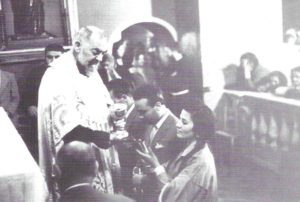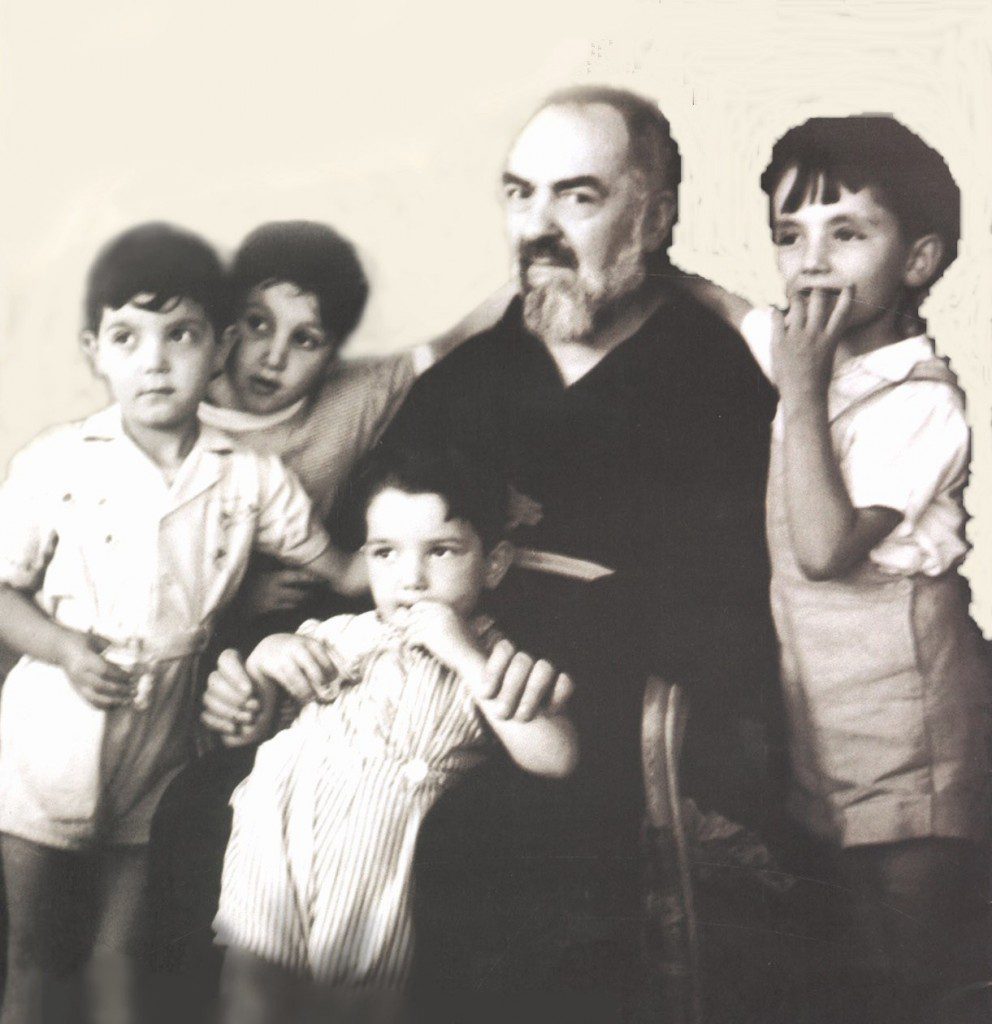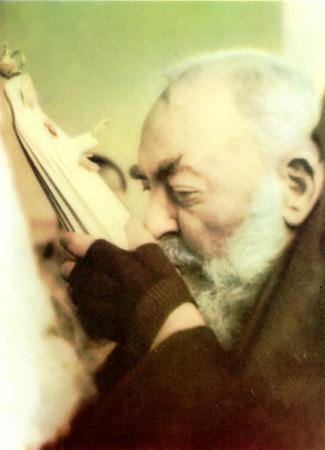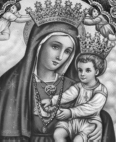Blessed Padre Pio, who on the altar elevated a never-ending
prayer to Our Lord and gathered much spiritual fruit
for himself and others, must be an example of holiness to everyone,
because all men are called to sanctity.
– Cardinal Francis Arinze
The Clergy Remembers Padre Pio – Part I
We recently visited Fr.Flavian Willathgamuwa CMF, PhD where he resides in Duarte, California and he shared his testimony with us regarding the three months he spent with Padre Pio in 1967.
Born in a village in Sri Lanka in 1919, Don Maximus Willathgamuwa entered the De La Salle Congregation of Christian Brothers when he was 17 years old, and thereafter became known to everyone as Brother Flavian. The mission of the Christian Brothers, which is a teaching Order, is to give a Christian education to youth, especially to youth who are poor. Brother Flavian served as the rector of St. Benedict’s College in Sri Lanka and later was elected by his congregation to be the Provincial Superior of the Christian Brothers for the province of Sri Lanka, India and Pakistan. He was appointed as Minister of Education by the President of Sri Lanka and served in that capacity for a time.
In 1967, Brother Flavian was sent to Rome to complete a year of studies. While in Rome, he read a newspaper article about Padre Pio, whom he had not heard of before. The article said that Padre Pio had a reputation for holiness and went on to mention some of the miracles and extraordinary spiritual gifts that were manifested in his life.
Brother Flavian had always been greatly attracted to individuals who had a reputation for sanctity and as a Brother of the De La Salle Religious Congregation, he had met a number of very holy people in his life. Living in Sri Lanka, very close to India, he had the privilege to meet and work with Mother Teresa. She invited him to come to India and be the Chaplain for her Missionaries of Charity sisters. He accepted her invitation and served at her convent in Calcutta.
He also met Sister Lucia Dos Santos, the Carmelite nun of Coimbra, Portugal, who, along with Jacinta and Francisco Marto, (both have since been beatified) received the apparitions of Our Lady of Fatima. He felt fortunate to visit the stigmatist and suffering soul, Sister Agnes Sasagawa of Akita, Japan. For years, the apparitions of the Blessed Virgin Mary that were received by Sister Agnes in the convent chapel in Akita were scrutinized and studied by the Church. In 1988, the Prefect for the Congregation for the Doctrine of the Faith, at that time, Joseph Cardinal Ratzinger, gave definitive judgement on the Akita apparitions as supernatural in origin, reliable and worthy of belief. In New York, Brother Flavian worked with the famous Catholic advocate for human rights, Dorothy Day, and at the Trappist monastery in Gethsemane, Kentucky, he met the famous Christian writer and Trappist monk, Father Thomas Merton.
Brother Flavian found the newspaper article about Padre Pio so interesting that he decided to make the four-hour train trip from Rome to San Giovanni Rotondo to visit him. He arrived at his destination in the middle of the night and was told that if he wanted to attend Padre Pio’s 5:00 a.m. Mass, he should go at once to the church and wait for the doors to open. Brother Flavian did just that. He couldn’t believe the large crowd that was already assembled in front of the church, waiting in the darkness. When the church doors finally opened, the crowd of people rushed forward and ran to the seats in the front of the church. The local Italian people jealously guarded the best seats, close to the altar where Padre Pio would be saying Mass. Brother Flavian had to sit in the very back of the church.
Brother Flavian went to the monastery afterward and introduced himself. The Capuchins welcomed him and asked him to stay in the monastery for the duration of his visit. The next day, he was invited to be up on the altar when Padre Pio celebrated his Mass. He knew what a privilege it was to be so close to Padre Pio at the Mass. During the Consecration, Brother Flavian happened to glance down at Padre Pio’s feet. He saw that they were not touching the ground. He looked again very closely to make sure he was seeing correctly, but there was no doubt. There was the carpeted floor. Padre Pio’s feet were elevated above it. His half gloves were removed during the Mass and Brother Flavian could see the wounds of the stigmata in his hands. He was awestruck by what he had witnessed.
Brother Flavian called the Father Provincial of his Order in Rome and told him that he had been planning to stay in San Giovanni Rotondo for five days but he wanted to stay longer. He told his Superior that he was in a holy place, the very air he breathed was holy. And Padre Pio was a saint. He could not bear to leave so soon. The Provincial gave Brother Flavian permission to stay for three months.
Every day, for the next three months, Brother Flavian attended Padre Pio’s Mass and every week he made his confession to him. He did not speak Italian and Padre Pio did not speak English, but oddly enough there was no language barrier. He spoke to Padre Pio in English and Padre Pio understood him. Padre Pio used to say that one of the special duties of his guardian angel was to translate foreign languages for him.
During Brother Flavian’s three month stay in the monastery of Our Lady of Grace, he was able to observe closely the life of the Capuchins, and in particular, Padre Pio. Padre Pio got up every morning at 3:00 a.m. to pray and begin his preparation for Mass which he celebrated at 5:00 a.m. Afterward, he would have a glass of orange juice and then hear the women’s confessions. Brother Flavian noticed that Padre Pio had a slow and dragging walk and he limped as he made his way to the confessional each day. It was extremely painful for Padre Pio to walk on his pierced feet. He once said that he was always in pain when he carried out his priestly ministry.
Brother Falvian observed that people from all over the world were at Padre Pio’s monastery to attend his Mass and make their confession to him. The confession lines were very long. Everyone had to take a ticket and wait for their number to be called in order to make their confession to Padre Pio. People sometimes waited eight days or longer.
He heard the women’s confessions until 1:00 p.m., had a very light lunch, and then heard the men’s confessions until 4:00 p.m. It was not unusual for him to hear confessions much longer and at times he would spend sixteen hours a day in the confessional. In his lifetime, Padre Pio reconciled thousands of people back to their faith through the sacrament of confession.
Padre Pio had a great capacity for work and a great capacity for suffering. It was extraordinary that he was able to spend such long hours in the confessional, especially considering his chronic health problems. His doctors were never able to successfully diagnose and treat the mysterious illnesses that plagued him throughout his life. He once said, “Confession is a work, but when one is ill, it becomes a sacrifice.” Pope Paul VI said of Padre Pio, “He was a man of prayer and suffering.”
After Padre Pio finished hearing confessions for the day, he walked on the veranda of the monastery for a short time of relaxation. Even then, people were trying to get near him, to speak to him a moment, to ask for his help and his prayers.
There were letters too, hundreds of them, that Padre Pio received every day from all over the world. One of the rooms in the monastery was converted into a small post office and a team of Capuchins, who spoke a variety of languages, were assigned to help. For many years, Mary Pyle, who lived nearby, answered the mail almost singlehandedly. Although Padre Pio prayed almost continuously throughout the day, he felt the need to pray even more, considering the tremendous number of prayer requests that were coming in through the mail.
At 4:30 p.m. Padre Pio blessed religious articles. At 5:30 p.m., he had a glass of beer and afterward gathered with the other Capuchins for a brief time of fellowship and conversation. After the evening prayers with his religious community, he went to his cell. The Superior of the monastery told Brother Flavian that when Padre Pio retired to his cell, it was not to sleep but to continue his prayers. He slept very little, not more than three hours every night.
Brother Flavian was curious about the daily glass of beer that Padre Pio drank. Being from Sri Lanka, this was not a part of the culture that Brother Falvian was accustomed to. In Sri Lanka, the clergy did not drink beer, wine or any other alcoholic beverages. He asked the Superior of the monastery about it. The Superior explained to him that there was a problem with the quality of the drinking water in San Giovanni Rotondo. Practically everyone drank beer instead, enjoyed it, and considered it much safer to drink. Brother Flavian also noticed Padre Pio’s extremely small intake of food. Every afternoon in the refectory, while he and the other Capuchins enjoyed their meal, Padre Pio would take only a few bites of food. He skipped breakfast and dinner altogether.
Several times Brother Flavian walked passed Padre Pio’s cell at the monastery, and saw that he was kneeling, deeply absorbed in prayer. His whole life was prayer, suffering the wounds of Christ’s Passion, carrying out his priestly ministry, serving the people, more prayer, more work, more suffering, more service.
For Padre Pio, every day was exactly the same as the previous. The schedule never changed. The article that Brother Flavian had read in the newspaper in Rome had been right. Padre Pio was indeed, a man of miracles, but perhaps the greatest miracle of all was his ability to endure the exhausting schedule, day in and day out, with very little rest or leisure. He kept up the enormous burden of work for more than fifty years without taking even one day’s vacation.
The three months passed very quickly and when it was time for Brother Flavian to return to Rome, he knelt down and asked Padre Pio to give him a word of advice for his religious vocation as a De La Salle Christian Brother. Padre Pio said to him, “Have a great love for the Mass and for the Holy Eucharist and have a great devotion to the Virgin Mary and to her Rosary. If you do this, you will enter Heaven and I will meet you there.”
Brother Flavian took the advice of Padre Pio to heart and consecrated his religious vocation to the Eucharist and to the Blessed Virgin Mary. He has also made great efforts to promote the Holy Rosary, the prayer that Padre Pio loved above all others.
While studying for an advanced degree in Chicago, Illinois, one of Brother Flavian’s classmates, a priest who was Chinese, told him that he was going to his father’s funeral in Beijing, China. He asked Brother Flavian if he would like to accompany him and he agreed to go. When they were at the cemetery, as the priest was saying the funeral Mass, soldiers came and arrested him. He was never seen nor heard from again. There are severe restrictions regarding religious services in China and it is illegal to celebrate Mass in public.
The people who were at the funeral begged Brother Flavian to continue the Mass. He tried to explain to them that he could not do so since he was not a priest but a brother. The people did not understand. To comfort the people, Brother Flavian then led a prayer and the sentiments he expressed were more for their sake than for his own. He prayed that if it was God’s will, he would become a priest and would some day return to China and say Mass for the people. Strange to say, shortly after saying the prayer, he began to feel for the first time in his life, a burning desire to enter the priesthood. He searched for a religious congregation that had a strong devotion to Mary, the Mother of God. He found that congregation in the Missionary Sons of the Immaculate Hear of Mary, also known asthe Claretians, founded by St. Anthony Mary Claret. At age sixty, he began his studies for the priesthood.
After ordination, Fr. Flavian was able to return to China and celebrate the Eucharist. However, he was arrested by Chinese police officers and put in jail and later ordered to leave the country.
Later, while in England, Fr. Flavian became gravely ill and spent many weeks the hospital. His condition was so serious that he was given the Last Rites. The Mother Superior of the Carmelite nuns in California learned of his illness. Fr. Flavian had regularly celebrated First Saturday Devotions to the Blessed Virgin Mary at the Carmelite chapel when he resided in California. The Mother Superior asked him to come to the skilled nursing facility that the Carmelite Sisters own and operate in Duarte, California. The Sisters wanted to provide him with the best medical care possible.
Fr. Flavian accepted the invitation and has lived at the Santa Teresita skilled nursing home for three years. Although confined to a wheelchair and almost blind, and weakened by many serious health problems, he has been able to carry on a busy and fruitful apostolate. He offers two masses daily to the people who visit him at Santa Teresita. Seven days a week he invites everyone to pray the Divine Office with him, followed by the Rosary. The Divine Mercy chaplet is recited at 3:00 p.m. daily. He organized the Pro Life Prayer Warriors prayer group who pray the Rosary together in his hospital room every Saturday for the sanctity of life. He also leads the First Saturday Devotions to the Immaculate Heart of Mary. Our Lady of Perpetual Help Devotions are held every Wednesday. In between, Fr. Flavian manages to pray fifty decades of the Rosary daily. “I plan to serve the Lord and use my time for God’s purposes, until I draw my last breath. I consider everything else a waste of time,” Father Flavian said.
At 88 years old, Fr. Flavian is not too many years away from the gate of Heaven. “Stay very close to the Holy Mass and to the Blessed Virgin Mary. If you do, you will enter Heaven and I will meet you there.” These words that St. Pio spoke to Fr. Flavian so many years ago have been a great consolation to him and he has stayed very close to the Holy Mass and the Blessed Virgin Mary.
________________________________
A Testimonial
I met Padre Pio only once in my life, when from Rimini, I went to see him in 1938, in order to make my confession. At that time I was 17 years old. I had just left the Capuchin noviciate of Cesena and I had no special program for my future life. During our talk, Padre Pio told me that I would be a missionary and would work in many countries. At that time I had no intention to join the friary again. So I didn’t know if his words were a prophecy.
But the fact is that on November 13, 1938, I was received into the Capuchin noviciate of Cesena and ordained a priest on May 25, 1945. In 1947, I was sent to India where I worked in the diocese of Lucknow up to 1964. After that, I was transferred to Tanzania, then sent to Ethiopia and for the last 12 years have been working in Dar es Salaam.
Now, remembering the words that Padre Pio told me in 1938, I realize that they have come true. So I am convinced that Padre Pio was a saint, who had the gift of prophecy. He has followed me silently in my missionary activities, though for a long time I did not remember him. Now, more than ever, I feel that he has protected me in all the critical moments of my life and so I feel very grateful to him.
– Fr. Costanzo Perazzini
________________________________
Memories of Padre Pio
Padre Pio had a great, lifelong esteem for the missionary vocation. Even before he was ordained, Padre Pio had thought about becoming a missionary. After he became a priest, he approached his Superiors and requested that he be sent to serve in the Capuchin missions in India, but his Superiors did not grant him permission.
On February 17, 1921, Padre Pio wrote a letter to the Capuchin missionary, Angelo Poli, O.F.M. Capuchin, Bishop of Allahabad, India. He asked Bishop Poli to pray regarding his fervent desire to become a missionary. Padre Pio wrote, “May you also recommend this affair to Jesus and tell Him that if He wishes me to be among His missionaries, let Him dispose my Superior’s will accordingly. And meanwhile, since it is not yet conceded to me to be in reality, one of His missionaries, I will do my best to be a missionary in spirit.” In another letter to Bishop Poli, Padre Pio wrote, “How much I desire and how content I would be if I also could find myself there so as to offer my poor work for the spreading of the faith.”
However, Divine Providence had other designs for Padre Pio and serving in the foreign missions was not a part of God’s plan for his life. One is reminded of the French Carmelite nun, St. Therese of Lisieux. Padre Pio had a devotion to St. Therese and had read her autobiography, “The Story of a Soul.” She, too, expressed a desire to be sent to the foreign missions but it was not meant to be. As a cloistered Carmelite nun, Therese’s vocation was to prayer within the convent walls.
Padre Pio wanted above all things, to live and act according to God’s will. Without ever leaving the monastery in San Giovanni Rotondo, he carried out an immensely fruitful apostolate and helped countless souls by his wise counsel, by his continual prayers and by his fidelity to God. Instead of going out to the world, as in the ordinary missionary sense, the world came to him. The poor and obscure monastery of Our Lady of Grace became the destination of thousands who were seeking a deeper spiritual meaning in their lives. For more than fifty years, Padre Pio exercised his priestly ministry in a true missionary spirit.
From Our Spiritual Director
Every week, I hear many beautiful testimonies of blessings and miracles that people are receiving through the intercession of St. Pio. One incident that happened recently regarded three non-Catholics who came to our Padre Pio Devotions. When they were returning home, they noticed the fragrance of roses which permeated their car to the extent that they had to stop the car and roll all of the windows down. The fragrance was so strong that it was overpowering.
A lady told me recently that an intense fragrance of perfume filled her home and she could find no explanation for it. She said it was a definite fragrance of perfume, although it was not her favorite perfume. She asked me the meaning of it. I told her that it was Padre Pio and that he often made his spiritual presence know by such a fragrance. He was giving her a blessing in this way.
A woman recently told me that she had a very vivid dream of Padre Pio. In her dream, Padre Pio was staring at her and the expression on his face was one of great seriousness. As he looked at her, he seemed very sad. The lady asked me what this dream might mean. I told her that Padre Pio was not happy with her double life. “You must go to confession and amend your life,” I said.
Padre Pio used to say that he would be able to do more for us when he was in Heaven than he could do for us while on earth. St. Pio is keeping his promise. The graces people are receiving from his intercession are truly amazing. But I believe that we do not thank him enough for what he has done for us in the past, what he is doing for us now, and what he will do for us in the future. We must remember to thank Padre Pio every day for his intercession and help in our lives.
– Fr. Louis Solcia C.R.S.P.







 Our Lady of Pompeii was especially dear to his heart and often when he needed a special grace for himself or for someone else, he would ask his friends to pray to Our Lady of Pompeii for his intentions. He wrote, “I should like to ask you, if it is not inconvenient, to do me the kindness of making three consecutive novenas to the Virgin of Pompeii for a grace to be obtained for me from her Son, a grace which will mean a great deal for a certain soul.” On another occasion he wrote, “I thank you for the novenas you made for me to Our Lady of Pompeii and I would ask you if it is not inconvenient, to continue because I am in great need.”
Our Lady of Pompeii was especially dear to his heart and often when he needed a special grace for himself or for someone else, he would ask his friends to pray to Our Lady of Pompeii for his intentions. He wrote, “I should like to ask you, if it is not inconvenient, to do me the kindness of making three consecutive novenas to the Virgin of Pompeii for a grace to be obtained for me from her Son, a grace which will mean a great deal for a certain soul.” On another occasion he wrote, “I thank you for the novenas you made for me to Our Lady of Pompeii and I would ask you if it is not inconvenient, to continue because I am in great need.” I like very much the true story regarding Mr. Joachim Bouflet and his encounter with Padre Pio that took place in August 1968. Joachim was a student at the University of Paris and for a long time had been considering becoming a Carmelite priest.
I like very much the true story regarding Mr. Joachim Bouflet and his encounter with Padre Pio that took place in August 1968. Joachim was a student at the University of Paris and for a long time had been considering becoming a Carmelite priest.